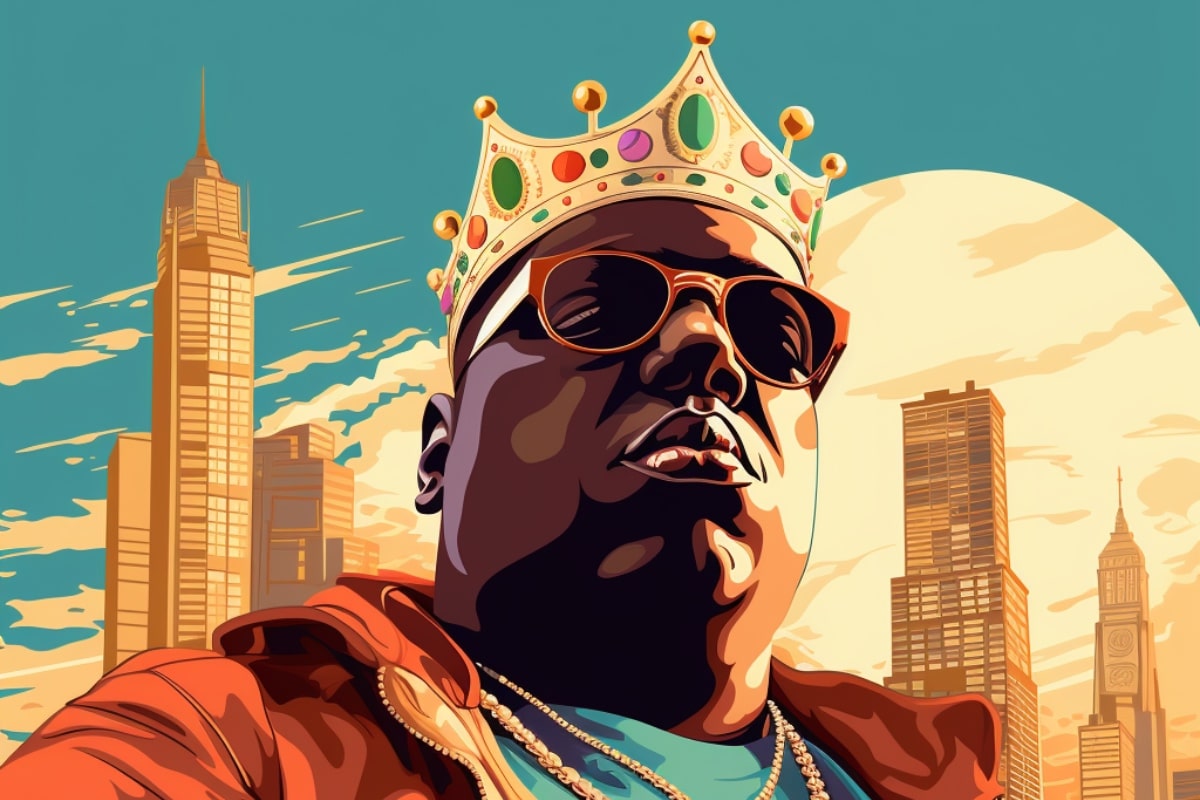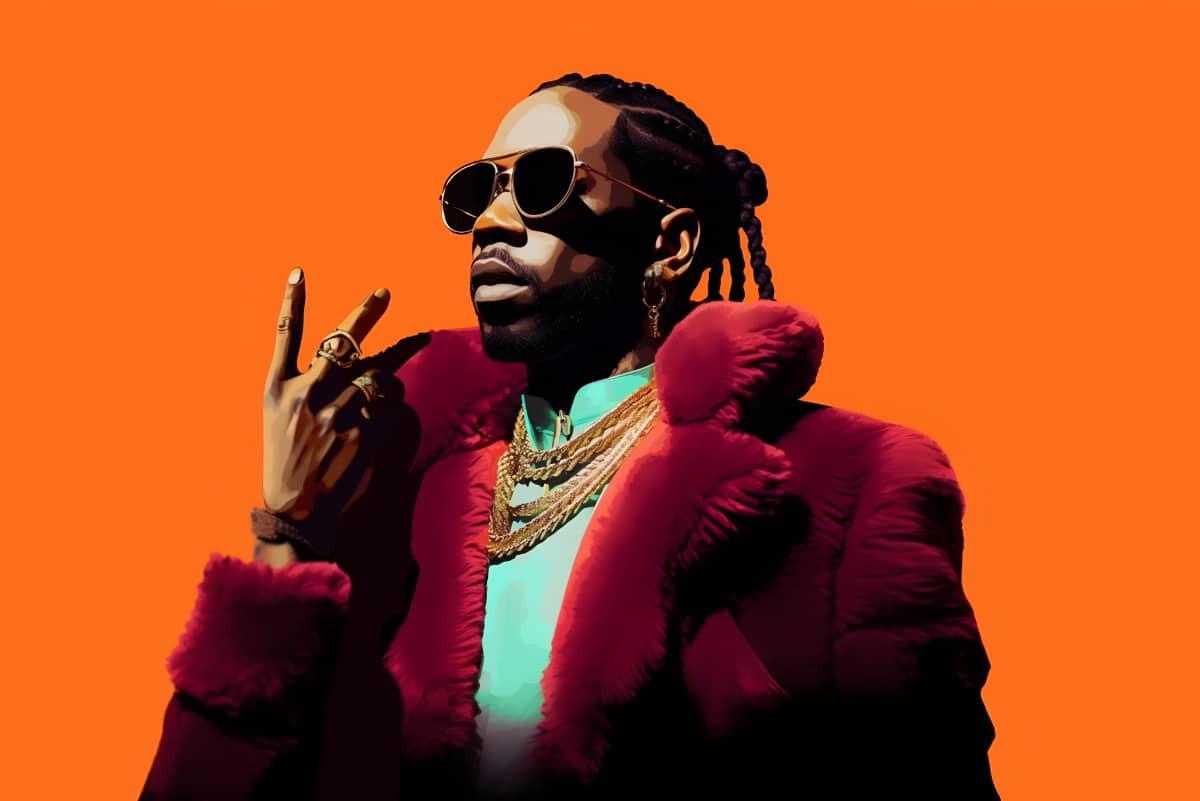Yo, peep this: New York City – that’s where hip hop was spit into existence, where beats pulsed through concrete and rhymes were scribed on subway walls. Ain’t just about birthplace status, though. NYC, that’s the battleground where rap royalty gets crowned. King of New York? That title ain’t bling, it’s the microphone scepter, the symbol that you run the whole damn East Coast scene.
See, back when hip hop was still raw and hungry, the fight for that crown was ruthless. Legends like Biggie, Nas, Jay-Z, and the whole Wu-Tang Clan – they threw down lyrical gauntlets, dropped diss tracks hotter than mixtapes fresh outta the oven. It was a golden era.
We gonna rewind to those days when Biggie Smalls ruled supreme, his flow hypnotizing the streets like nothin’ else. But then, the game shifted – Queensbridge birthed a hustler named 50 Cent, and his rise was meteoric, empires crumbling in his wake.
Get ready, ’cause we about to dissect this legacy of lyrical warfare, break down the reigns, and analyze who truly deserves to be called King of New York and when – as time shifts, the crown would get passed on.
May 3, 1993 to January 18, 1994: Method Man
Albums: Enter the Wu-Tang (36 Chambers)
Singles: “Method Man” (#69 on Billboard Hot 100)
Contenders: Biggie, Nas
By 1993, the West Coast was running hip hop. That’s just a fact. After years of the East Coast innovating the hip hop artform and dominating the culture, Dr. Dre, Snoop Dogg and the Death Row crew detonated an atomic bomb laced with the purest G-funk sounds that helped L.A. take over the hip hop industry. While this was happening, an enigmatic group comprised of nine masked ninjas were plotting their entrance into the rap game. Out of the Shaolin crew of killer lyricists, it was Method Man who emerged as the number contender for the King of New York title, bringing a hot liquid flow and electrifying energy every time he blessed the mic. Wu-Tang’s first single, “Protect Ya Neck,” had already generated an underground buzz, but it was the 1993 re-release with the unforgettable “Method Man” as the B-side that catapulted the group into hip-hop stardom. The single sold a staggering 10,000 copies, and the eponymous track reached #69 on the Billboard Hot 100. Around this time, Biggie and Nas were making their come-up, but Meth’s gritty flow, husky voice and captivating stage presence helped to set him apart from the pack, securing his place in the conversation of the King of New York.
January 18, 1994 to August 9, 1994: Nas
Albums: Illmatic
Singles: “It Ain’t Hard to Tell” (#91 on Billboard Hot 100), “The World Is Yours” (#27 on Hot Rap Songs)
Contenders: Biggie, Method Man
From the moment Nas burst onto the scene with his game-changing feature verse on Main Source’s “Live at the Barbeque,” he was anointed the second coming of Rakim. After taking a few more years to work on his debut album, the Queensbridge MC would unleash his first single “Halftime” in 1992, then “It Ain’t Hard to Tell” at the beginning of 1994. From that moment on, Nas would hold the crown as the undisputed King of New York, galvanising the city’s hip hop scene with his elevated poetry in motion and vivid storytelling. During this era, the electric energy of New York’s rap scene pulsed with the undeniable presence of talented contenders like Biggie and Method Man. However, it was Nas’s magnetic charisma and the sheer brilliance of Illmatic that shone brightest, casting a long shadow over his competition.
August 9, 1994 to June 4, 1996: The Notorious B.I.G.
Albums: Ready to Die
Singles: Juicy” (#27 on Billboard Hot 100), “Big Poppa” (#6 on Billboard Hot 100), “One More Chance (Stay with Me Remix)” (#2 on Billboard Hot 100), “Player’s Anthem” (#13 on Billboard Hot 100), “Get Money” (#17 on Billboard Hot 100), Total’s “Can’t You See” (#13 on Billboard Hot 100)
Contenders: Nas, Raekwon, Prodigy
When it comes to the title of King of New York, few rappers have ever held the crown as convincingly as The Notorious B.I.G. While Nas was sitting on the throne for the first half of 1994, as soon as Big’s lead single “Juicy” dropped on August 9, followed by Ready to Die a month, it was clear to the city who the new king was. Other rappers would have longer and more dominant reigns as the King of New York, Big did it during a time when it was most competitive – not only did you have Nas fresh off dropping Illmatic (arguably the greatest hip hop album of all time) you also had the likes of Wu-Tang, Mobb Deep and Jay-Z lurking in the cut. While the Brooklyn rapper’s explosive lyricism and vivid storytelling made him a favourite of all hardcore hip hop heads, his smooth flow and undeniable charisma made him an instant hit with the masses – something that Nas didn’t achieve until later on. Singles like “Big Poppa,” and “One More Chance (Stay with Me Remix)” cemented his status as a rap superstar, and his collaborations with other artists like on Total’s “Can’t You See” only added to his mass appeal and securing his reign.
June 4, 1996 to March 4, 1997: Nas
Albums: It Was Written
Singles: “If I Ruled the World (Imagine That)” (#53 on Billboard Hot 100), “Street Dreams” (#22 on Billboard Hot 100), “Affirmative Action” (#78 on Hot R&B/Hip-Hop Songs)
Contenders: Jay-Z, Biggie
After the release of Illmatic, Nas had firmly established himself as one of the most lyrically-gifted MCs of his generation, and it wasn’t a stretch at all to call him the best rapper alive. However, Big’s larger-than-life presence, explosive flow and Puffy’s guiding hand had cemented the Brooklyn rapper as the new King of New York. Nas was faced with two options for his sophomore album: stick to the gritty, street-focused sound of his debut, or branch out and try to appeal to a wider audience. He went with the latter option. Released in 1996, It Was Written saw the Queensbridge rapper switch up his formula, embracing a more polished, mainstream-friendly sound that was a departure from the raw, unfiltered energy of Illmatic. The album featured big-name producers like Dr. Dre and Trackmasters, and buzzing guest appearances from the likes of Lauryn Hill and Foxy Brown. The decision to go in this direction paid off – It Was Written was a massive commercial success, debuting at #1 on the Billboard 200 while singles like “If I Ruled the World (Imagine That)” and “Street Dreams” climbed the charts and solidified Nas’ place as one of the biggest rappers in the world, let alone New York.
March 4, 1997 to March 9, 1997: The Notorious B.I.G.
Albums: N/A
Singles: “Hypnotize” (#1 on Billboard Hot 100)
Contenders: Nas, Jay-Z
After reigning as the King of New York for the better part of two years, Biggie had his crown snatched off him when Nas re-emerged as a phenomenal lyrical talent who could also make big records. So Big fell back and starting plotting on his sophomore album — the one that would make every New York rapper see who the true number one MC was. Though Biggie didn’t release any albums during this period, his single “Hypnotize” quickly became a massive hit, reaching the #1 spot on the Billboard Hot 100. Unfortunately, Biggie’s second reign was tragically short-lived, just as he was about to get going again. On March 9, 1997, just days after “Hypnotize” reached the top of the charts, he was gunned down in Los Angeles at the age of 24. His death marked the end of an era, but not before he cemented his position as one of the greatest rappers of all time.
March 9, 1997 to May 5, 1998: Puff Daddy
Albums: No Way Out
Singles: “Can’t Nobody Hold Me Down” (#1 on Billboard Hot 100), “I’ll Be Missing You” (#1 on Billboard Hot 100), “Been Around the World” (#2 on Billboard Hot 100), “Victory” (#19 on Billboard Hot 100), The Notorious B.I.G.’s “Mo Money Mo Problems” (#1 on Billboard Hot 100)
Contenders: Jay-Z, Mase, Nas
While Big was preparing the release of Life After Death, Harlem superstar Puffy was already in the cut working on his debut album which was originally called Puff Daddy & the Goodfellas, then switched to Hell Up in Harlem before he settled on No Way Out. Before “Hypnotize” skyrocketed up the charts, Puff already had his number one single with “Can’t Nobody Hold Me Down,” the shimmering Mase-featured anthem that sampled both Grandmaster Flash and the Furious Five’s “The Message” and Matthew Wilder’s “Break My Stride” in a way that only Puffy could pull off. In the wake of the Big’s untimely death on March 9th, Puff emerged as the next King of New York. Following the success of “Can’t Nobody Hold Me Down,” Puff scored another number one hit with his heartfelt tribute to Big, “I’ll Be Missing You”, as well as “Been Around the World” which peaked at number 2 on the charts. Even with Jay-Z coming up around this time with his platinum-selling In My Lifetime, Vol. 1, Nas with his Firm crew and Mase’s Harlem World, it was clear that Puffy had solidified his position as the King of New York.
May 5, 1998 to July 28, 2001: DMX
Albums: It’s Dark and Hell Is Hot, Flesh of My Flesh, Blood of My Blood, … And Then There Was X
Singles: “Ruff Ryders’ Anthem” (#16 on Billboard Hot 100), “How’s It Goin’ Down” (#70 on Billboard Hot 100), “What’s My Name?” (#67 on Billboard Hot 100), “What These Bitches Want” (#49 on Billboard Hot 100), “Party Up (Up in Here)” (#27 on Billboard Hot 100), Jay-Z’s “Money, Cash, Hoes” (#19 on Hot Rap Songs)
Contenders: Jay-Z, Mase, Nas, Ghostface Killah
“Stop, drop, shut ’em down, open up shop, oh, no, that’s how Ruff Ryders roll.” By the beginning of 1998, it was becoming evident to the people of New York that a new era of rap superstars were emerging. From Mase and Puffy leading the Bad Boy charge to Jay-Z transcending his Brooklyn roots to becoming a real player in the rap game, the city was going through a major transitional phase following the death of Big. Out of all the rappers to emerge, one Yonkers rapper stood tall as the one most likely to ascend to the throne. With his major-label debut single “Get at Me Dog” and legendary “Ruff Ryders’ Anthem,” DMX staked him claim to the crown. DMX’s seizing of the King of the New York title also marked a dramatic shift in the rap game as he brought back a raw, street-oriented aesthetic that pushed back against Puffy’s R&B-infused samples and glossy production. With his one-two punch of It’s Dark and Hell Is Hot and Flesh of My Flesh, Blood of My Blood, dropped in the same year no less, X transformed into the new King of New York. From there, the rapper cemented his claim with … And Then There Was X the following year, which also featured the 2x platinum hit single “Party Up (Up in Here).”
July 28, 2001 to January 7, 2003: Jay-Z
Albums: The Blueprint, The Blueprint 2: The Gift & The Curse, S. Carter Collection, The Black Album
Singles: “Izzo (H.O.V.A.)” (#8 on Billboard Hot 100), “Girls, Girls, Girls” (#17 on Billboard Hot 100), “Jigga That Ni**a” (#17 on Billboard Hot 100), “’03 Bonnie & Clyde” (#4 on Billboard Hot 100), Scarface’s “Guess Who’s Back” (#79 on Billboard Hot 100), Freeway’s “What We Do” (#97 on Billboard Hot 100)
Contenders: Nas, Cam’ron, Prodigy
While Jay-Z became one of rap’s biggest superstars in 1998, with the release of Vol. 2… Hard Knock Life — which became his first number one album and eventually sold over 5 million copies — the Brooklyn MC was still overshadowed by the rocket ship that was DMX. It wasn’t until 2001, leading up to him dropping The Blueprint, that Hov would finally snatch the King of New York crown for himself. Bolstered by the Kanye-produced lead single “Izzo (H.O.V.A.),” Jay-Z would aim shots at rivals on “Takeover,” trade bars with the biggest rapper in the world on “Renegade,” get introspective on “Never Change,” flex his position on “Hola’ Hovito” and remind everyone who the fuck he was on “U Don’t Know.” Seamlessly bridging the gap between the streets and the radio, there was no other rapper in the world better at capturing the zeitgeist of hip hop culture while dominating the airwaves like Hov.
January 7, 2003 to September 11, 2007: 50 Cent
Albums: Get Rich or Die Tryin’, Beg for Mercy, The Massacre, Get Rich or Die Tryin’ (soundtrack), 50 Cent: Bulletproof (soundtrack), Curtis
Singles: “In da Club” (#1 on Billboard Hot 100), “21 Questions” (#1 on Billboard Hot 100), “P.I.M.P. (Remix)” (#3 on Billboard Hot 100), “If I Can’t” (#76 on Billboard Hot 100), “Stunt 101” (#13 on Billboard Hot 100), “Wanna Get to Know You” (#15 on Billboard Hot 100), “Disco Inferno” (#3 on Billboard Hot 100), “Candy Shop” (#1 on Billboard Hot 100), “Just a Lil Bit” (#3 on Billboard Hot 100), “Outta Control (Remix)” (#6 on Billboard Hot 100), “Hustler’s Ambition” (#65 on Billboard Hot 100), “Window Shopper” (#20 on Billboard Hot 100), “Best Friend” (#35 on Billboard Hot 100), “Straight to the Bank” (#32 on Billboard Hot 100), “I Get Money” (#20 on Billboard Hot 100), “Ayo Technology” (#5 on Billboard Hot 100), Lil’ Kim’s “Magic Stick” (#2 on Billboard Hot 100), Young Buck’s “Let Me In” (#34 on Billboard Hot 100), “Encore” (#25 on Billboard Hot 100), The Game’s “Westside Story” (#93 on Billboard Hot 100), “How We Do” (#4 on Billboard Hot 100), “Hate It or Love It” (#2 on Billboard Hot 100), Tony Yayo’s “So Seductive” (#48 on Billboard Hot 100)
Contenders: Nas, Jay-Z, Cam’ron
The last true King of New York was Curtis James Jackson III aka 50 Cent. When you factor in his influence, strength of competition, and sheer cultural impact, then you’d probably have to say Biggie had the best reign as King of New York. However, 50 had the most dominant and it’s not even close. By 2002, the Queens rapper and his G-Unit crew were bubbling up out of the New York mixtape circuit and plotting their takeover of the rap game. Once 50 signed with Dr. Dre and Eminem, then it was a wrap for any other competitors. Backed by the Interscope, Aftermath and Shady Records machine, 50 Cent hit the industry like a tidal wave. Even one of his biggest enemies, Ira Gotti, conceded that once they heard “In da Club,” they realised they had a major problem on their hands. Balancing melodic, radio-ready hits with confrontational street anthems, 50 was a master at crafting his own brand and using that to build a music empire. Not only did he smash the rap game with Get Rich or Die Tryin’ and The Massacre, he also built up Lloyd Banks, Tony Yayo, Young Buck, and The Game (as short-lived as it was) into multiplatinum selling rappers. But it was all too much. Once 50’s prime was over, the New York rap game was in tatters, torn apart by various beefs and feuds, and with the arrival of the internet which helped to dispense any notion of regionalism in hip hop, the era of the King of New York was also finished.








